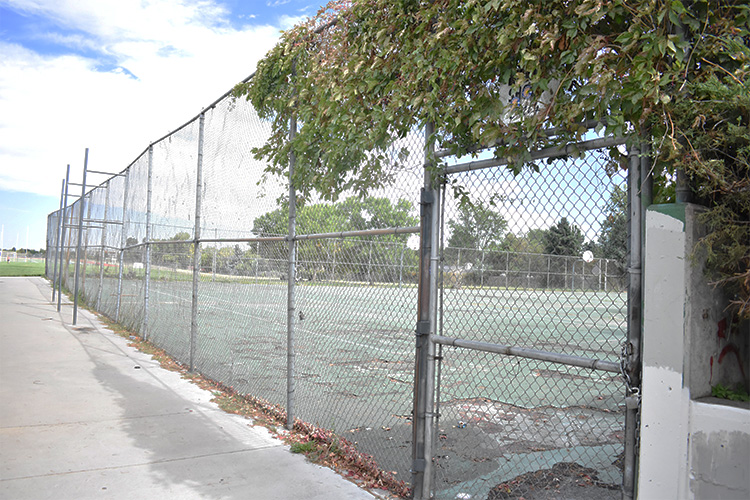
The empty TJ tennis courts are overgrown with torn-up concrete, and are in dire need of attention. photo by Ben Scherer
A deep dive investigation into TJ’s abandoned tennis courts.
For 20+ years, the four tennis courts on the far side of Thomas Jefferson High School have been abandoned. They have remained cracked, overgrown, unsafe, and are falling further into disrepair. With TJ’s growing tennis teams, it is time to push to get them revitalized. Between disputes over property lines, district bonds, and a surprising connection to TJ basketball, the story of the courts is rather intriguing.
The school population has grown by approximately 300 students in the last ten years, and Thomas Jefferson Athletics have been growing proportionally. In recent years, both Girls’ and Boys’ Varsity tennis teams have had to drive themselves to Eastmoor Swim and Tennis Club or Eisenhower Park for practice each day. The JV team is spread thin amongst the courts, sometimes having up to 10 athletes on one court. This has created an unproductive practice environment where athletes are barely getting any time to play and they don’t have enough courts to host home games or practice as a whole team. TJ’s athletic director, Anne Rice, stated, “I want to have tournaments here, I want to be able to host things, and right now the condition of the courts is that we really can’t.” These issues make it apparent that something needs to change.
At first it was an issue of ownership. The park next to TJ belongs to the city of Denver, and the courts are technically in the park. Rice said that she attempted to negotiate with them, however, “they were thinking that the courts were theirs and we were thinking that they were ours.” In the end, however, they lie within the campus property line, meaning that they are the school’s responsibility to maintain. The problem with this is that the cost of upgrading the courts is far more than the school’s spending capacity. Rice estimates that the school would have to spend at least ten years fundraising and it is not realistic for TJ to consider that as an option. Projects like this need to involve the district; fortunately, there are ways to get them involved.
Every four years there is a district-wide bond, Rice explained, “and if it passes that means that the voters in Denver agree to give a certain amount of money or have money allocated to schools.” Part of that money goes to getting upgraded facilities. In 2020, the bond was used for the new concession stand and turf for the football field, but TJ was unable to refinish the tennis courts at that time. Rice says she has put the courts on the bond for 2024, but the final decision is up to the district. This puts the court project at a standstill for the time being. She says that even if it does get approved, it could be at least another three and a half years before any progress is made.
But it is not as simple as just requesting refinished courts; another problem was brought to light by Grant Laman, the head boys’ basketball coach and former TJ student. He says that DPS high schools built after 1970 have two gyms to accommodate for seasonal practices of multiple athletic teams. However, TJ was built in 1960. This becomes a problem in the winter when both boys’ and girls’ basketball teams are trying to practice and there is not enough space. The solution to this was to have other basketball hoops somewhere on campus. The abandoned tennis courts were once the only courts and where the new tennis courts stand used to be recreational space with basketball hoops. When they built the new courts, they put basketball hoops in the old ones and used it as overflow space for the tennis and basketball teams. However, without proper maintenance, they became unusable and unsafe for both activities.
The players on the tennis and basketball teams need more space to practice, as it causes TJ to be disadvantaged compared to other DPS schools who have more courts and at least two gyms. It is unrealistic to build an entirely new gym for the school, but refinishing the abandoned courts would kill two birds with one stone. Laman explained that two years ago, Coach Mike Griebel, the head football coach, came up with a plan to resurface and cover the abandoned courts with a roof, turning it into a “field house” where basketball, tennis, and other teams could practice when their own facilities are not usable. This would protect the courts from weathering, and eliminate the disadvantages that girls’ tennis faces in comparison to boys’ due to snow in the spring season. The plan was put on hold, and would undoubtedly cost even more than simply refinishing them, but it did seem like the best way to handle the situation for all parties involved.
The crisis of the courts is one that has been going on for decades, but as time goes on, it only becomes more dire and more expensive. By ensuring that the problem does not continue to be overlooked, TJ can help to save these courts and the teams dependent on them. The district revitalizing this space would greatly benefit the TJ community and build a new future for TJ athletics.